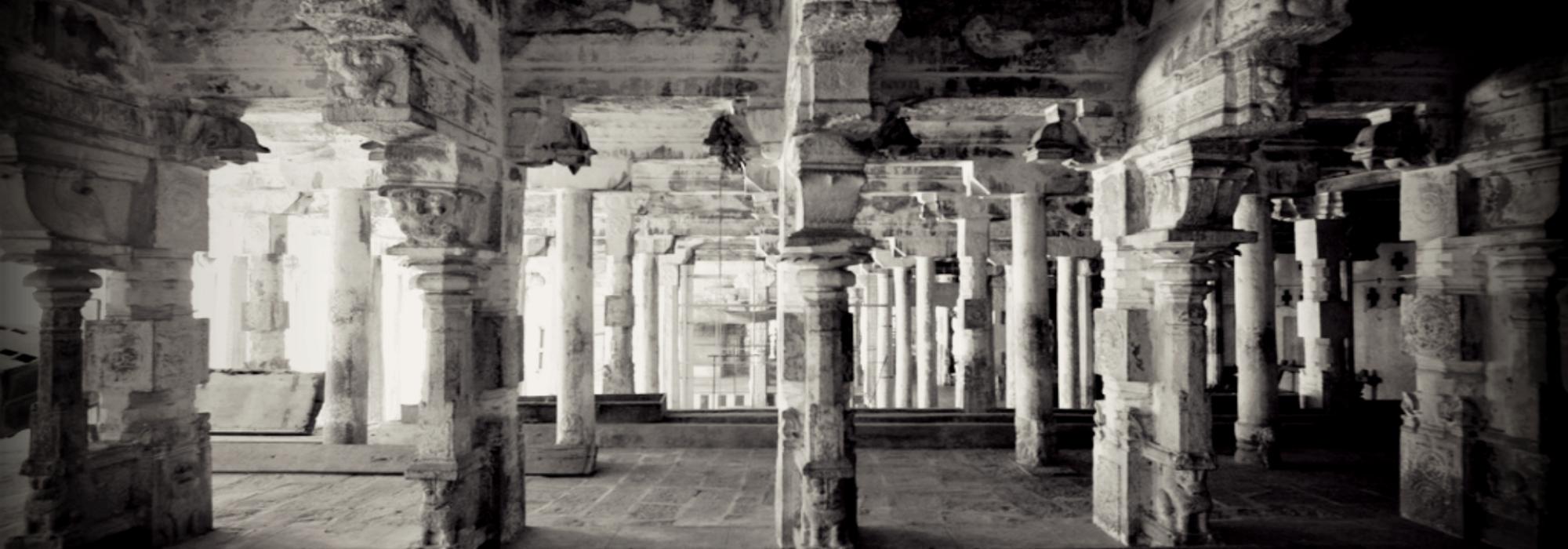Lessons in Brahmasutra Commentary
I had requested Sri Shastri to instruct me in [Adi Shankara’s] commentary on the Brahmasutras[i]. Equally, I had requested him to train me in two or three other Vedanta commentaries that I hadn’t seen so far, and entreated him that I had set aside two years for this Shastric study. He said that that period was insufficient. I said, “Let it go on for two years; if required, we can extend it for an additional six months.”
Lessons in Upanishad-commentaries everyday from eight thirty to eleven in the morning; training in the Brahmasutra commentary from three thirty to six in the afternoon. This was the typical timetable although it couldn’t be implemented on several days.
Veerakesari Sitaramashastri
I feel extremely happy to recall here that during my training in the commentaries on the Brahmasutras, “Brahmashri,” “Vedamurti,” “Veerakesari” Sitaramashastri favoured me by becoming my classmate. Around that time, he had written an introductory work on Tarka (Logic) in Kannada. He had read out some portions from it to me. I had requested him that if he completes and publishes it, it’d be a great service.
The hundreds of mistaken notions among our people regarding various subjects are root cause of today’s chaotic political state and economic mess. Those who wish to clean up the nation’s public life first need to inculcate among our people the practice of developing the wisdom of analyzing cause and effect [of various issues and events]. Logic is one subject that aids such analyses.
Scholarship in Tarka
Sri Virupaksha Shastri had earned worldwide renown as a towering Pundit in Tarka.
We can estimate the sort of easy authority that he commanded in Tarka from just one instance. In the lessons on Vedanta, arguments from different schools like Sankhya and Vaisheshika are considered for analysis. After introducing each of these schools separately, Sri Shastri would say, “According to our school, that is, not in the Tarka school but Vedanta school…” and would then proceed to elucidate.
In the initial days, he was renowned as a TArkika (Logician), which is why he obtained the “TarkapanchAnana” honorific. Thanks to the impact of the Sringeri Jagadguru, Vedanta obtained the pedestal that Tarka had occupied so far.
Propriety
Sri Virupaksha Shastri was endowed with integrity and spotless conduct in all matters. He’d never speak with either arrogance or jealous anger. He must speak the truth that lay in his soul and he must speak it fearlessly—this was his nature. He’d never bow his head down before any authority where it involved speaking the truth. Because everyone was aware of this, nobody was upset with him and everybody had reverence and respect towards him.
Sri Shastri was endowed with compassion towards all. He had experienced poverty, hardship, sickness and death in his personal life. His mind had become tender and gentle in this manner. As we noted earlier, my lessons were slated to begin at eight thirty in the morning. When I reached the Matha at exactly that hour, at times, it wasn’t possible for Sri Shastri to arrive on time. Some days, the delay would extend up to a half or three quarters of an hour. And so, on one such day of extreme delay, he said:
“Please listen, we speak about our family, our home. And in our home, no matter who behaves in what manner, no matter what they do…if we’re blind to all this, that’s a happy family, everyone’s happy. But the moment one begins to speak about Dharma at home, it’s no longer home, it’s an insane asylum.”
It appears that even he underwent this sort of experiences on occasion.
Guruvandana: Paying Obeisance to the Guru
Each time we assembled for our lessons and the moment Sri Shastri arrived, he’d ask, “Is Guru Vandana finished?” He wouldn’t be satisfied if I said, “Finished.”
“Let’s perform it once more—there’s no harm,” he’d say. Then, we—including him—would perform the SAshtAnga PranAma[ii] ten or twelve times before the Guru’s picture. In his lexicon, a count of “one” meant twelve prostrating times. Back then, I hadn’t yet become a barrel. Yet, Sri Shastri’s Guru Vandana procedure was physically arduous. But it appeared that the strain didn’t show on him. And the same Guru Vandana was repeated after the lessons were over for the day. As the days of Anadhyayana[iii] neared, a special Guru Vandana was scheduled! My limbs would fail.
After Guru Vandana and before the daily lessons began, “Sandhya Vandanam is completed, right?” Then came the question of Guru Vandana. Next:
V: “Yesterday’s lesson…it’s on your tongue-tip, right?”
Me: “I’ve seen it somewhat.”
V: “You’ve seen the text of today’s lessons, right?”
Me: “I’ve seen it a couple of times.”
The lessons would then begin.
My Difficulty
And so as it transpired like this: the questions about the previous and next day’s lessons, I finally made up my mind to tell him the truth. I said:
“I’m not studying this Shastra to become an authority. I’ll be content if I study enough to get an overall direction on the subject. It’s my fortune if I understand the overall methodology of the Shastra. My profession is different. I’m in politics; I’m working as a journalist. The subjects relevant to my profession and livelihood are political science and economics. Lots of new developments and theories arise in these subjects. New books are published each week. I need to read them. It’s impossible for me to obtain a command over Vedanta texts like a Pundit does. Neither do I have that desire.”
Sri Shastri listened to this patiently, took pity: “We’ll complete it as soon as possible.”
Despite this, he relaxed neither the procedure of Guru Vandana nor that of questioning about the lessons.
I couldn’t learn under him for sometime due to a tragedy in my home. Except for this, Sri Shastri’s regard for me was consistent.
Method of Instruction
How does one describe Sri Shastri’s method of instruction? He would narrate the explanations in Kannada. He would also use some English words in between. He would give illustrations from familiar situations like say, a rail journey. He would quote examples from [Sanskrit] poetry.
On occasion, he quoted an instance from the Champu Bharata while expounding on the nature of Maya [Illusion]:
“We must deduce that Draupadi was indeed endowed with a waist by using the method of inference. The upper and the lower part of the body were joined. Therefore, the head and the feet belong to the same body. And therefore further, that there must be an organ that joins both of them—we infer thus from the logic of concordance and discordance [Anvaya Vyatireka Tarka]. It was such a slender waist that we don’t know whether there really was a waist!
Maya is akin to this. Does it exist? No. Doesn’t it exist? Yes.”
This is a small sample of Sri Shastri’s method of instruction.
Sri Shastri had studied all the Kavyas and Puranas. Along with it, he was well-versed in traditional manners, which came from his expansive interactions with scholars. When he sat for imparting Vedic recitation, it appeared that he was a GhanapAThi. Such was the purity of his voice and his intonation of the udAttA and anudAtta[iv].
A Similie
On occasion, Sri Virupaksha Shastri used to narrate humorous tales in the flow of his lessons. He narrated this while explaining renunciation:
“You see, our tummy bloats up for some reason, making weird noises. Then we figure out: if we take an enema, the heaviness will disappear and the body becomes light again. Let’s sip a drop of castor oil and then wait for the ejection. It’s nine or ten but the heaviness remains. The oil just sits there in the tummy. Let’s say it’s eleven. Then we think: ‘This won’t work like this. We’ll finish our bath and Sandhya Vandanam and have lunch. The heat from the food will melt the impurity in the body and then the heavy stuff will slip out.’ And after such deliberations, when we finish our bath, dry our body and we’re about to sit for Sandhya Vandanam wearing the Sacred Garments, it announces its arrival! All that bath is completely wasted!
“Renunciation is exactly like this. Family, hardship, loans, embarrassments…after experiencing all these, we feel, ‘I’ve had enough of family life.” Then we go to the Guru, beseech him to bestow the Sanyasi’s attire and even as we’re getting our head shaved, the worries of wife and children enter our head: ‘I need to go away from such a good wife, such good children—my children are so brilliant! Why should I go away leaving them all!’
“Six months of renunciation vanishes in an instant.
“That’s the reason our renunciation is unreliable. Renunciation occurs the moment there’s loan and hardship. And the moment we spot a good sari, it flies away.
“It’s because of this that the Sringeri Jadadguru would never give Sanyasa to anyone. If somebody approached him for it, he’d say, ‘Just live like a Sanyasin. What’s there in it to give? It’s not something that one gives. Eat at the Matha. Serve Goddess Sharada. Listen to Puranas. Stay worriless. Isn’t that the meaning of Sanyasa?’ Despite this, if someone insisted, he’d say, ‘One shouldn’t trust the renunciation that occurs quickly.’
“Therefore, one shouldn’t be hasty for renunciation. One must examine whether the renunciation will remain steadfast and firm over a long period.”
To be continued...
This episode is a part of the iconic D.V. Gundappa’s series of pen portraits in the volume titled Vaidikadharma Sampradaayastharu (Traditional Vedic Scholars) forming part of his acclaimed Jnapaka Chitrashaale (The Art Gallery of Memories).
Footnotes
[i] Brahmasutras is a Sanskrit text attributed to Sage Badarayana. It systematizes and summarizes the philosophical and spiritual concepts embedded in the Upanishads and is considered as one of the foundational texts of Vedanta. All major Gurus, philosophers, and spiritual leaders in Hinduism including Adi Shankara, Madhvacharya, Ramanujacharya, Nimbaraka, and Vallabha have written commentaries upon it.
[ii] Lying completely prostrate on the ground with the entire body in a straight line.
[iii] Specific days during a year on which no lessons were taught.
[iv] Vedic accent comprises three parts: udAtta=”raised” or acute accent; anudAtta=”not raised” or “grave” or low accent; and svarita=”sounded” or circumflex accent.















































